List of Authors
>>About this blog
Recent blog post
|
[CAM]
October 22, 2015 18:00
In "Monoshiri Encyclopedia", only the following "Ginza Yanagi Monument" (Ginza 8-9 ahead) is described (page 47) for the willow monument in Ginza.
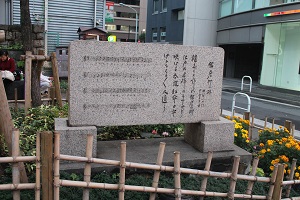
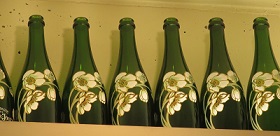
poetry monument written by Yaso Saijo and composed by Shinpei Nakayama, "Ginza Willow". Around 1887, willows planted in the city of Ginza as street trees became a specialty of Ginza with the development of the city. This song, which sang the willow, dominated the whole country. To commemorate this, on April 1, 1954, the Ginza Dorirenkai built this monument.
However, there are two separate monuments about willows in Ginza, one of which, "Yanagi Namiki Monument," is located at Sukiyabashi Park.
![IMG_1851[1]. jpg](https://en.tokuhain.chuo-kanko.or.jp/archive/IMG_1851%5B1%5D.jpg)
"Ginza's symbolic willow trees
The willows in Ginza were planted around 1877 and became a symbol of Ginza, but after three transitions, it disappeared with the renovation of Ginza Street in 1968.
This time, Nishi-Ginza Dori has been renewed as a symbol road in Tokyo with the expansion of the sidewalk along with the expansion of the sidewalk and the redesign of granite pavement, and the row of trees has been replaced with willows and the symbol of Ginza has been revived.
Nishi-Ginza Tsukai will build a monument here in Sukiyabashi Park in hope that this willow willow will continue to be loved and loved by people for a long time.
November 1999 Seiichi Yanagisawa, Chairman of Nishi-Ginza Dorikai "
And another "Ginza Yanagi-derived dictionary" is located in Ginza 1-chome.
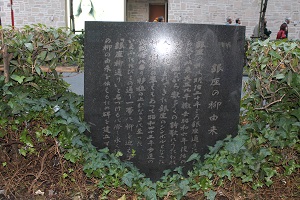
"Ginza's willowder"
Since the willow in Ginza was planted on Ginza Street around 1887, it was removed in 1920 and after the change of the revival in 1931, the willow, which became a symbol of Ginza, which was sung by many poems and became popular with people, also declined due to the decline of the vigor. In 1968, the transplantation was unavoidable due to the major renovation of the sidewalk.
Once again, a willow will be greeted around this street and named "Ginza Yanagi-dori St.", a monument will be erected to convey the origin of the willow in Ginza for a long time. Ginza Street Association "
Regarding this "Resurrection in 1931", the cargo wind describes as follows.
March 25, 1932, "... On the way home, see a notice called "Ginza's Yanagi Revival Memorial Festival" at the entrance of the Sukiyabashi Asahi Shimbun. When I use a religious word for such things, I look at this and feel suspicious and laughing. The word disturbance is a testament to the disturbance of the human mind. ・・・・」
[CAM]
October 22, 2015 16:00
"Sanjikenbori" is described on page 47 of "Monoshiri Encyclopedia".
At present, the following explanatory version is installed as "Sanjumabori Ruins" (some Chinese numerals are converted to arithmetic numerals).
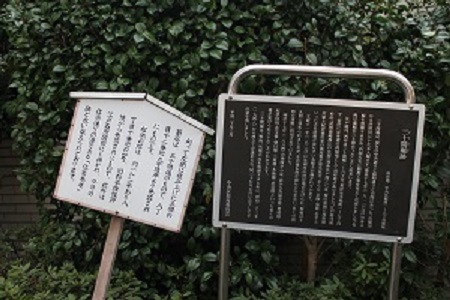 "The ruins of Sanjuma moat "The ruins of Sanjuma moat
Location 1-8, Ginza, Chuo-ku Region
Sanjumabori is an entrance between the current Chuo-dori and Showa-dori, from the Kyobashi River to the Shiodome River. In 1612 (1612), in order to maintain Funairi moat in Edo, it was completed by ordering the Saikoku Daimyo to open the excavation work. The name is derived from the fact that the moat width was thirty. In the Edo period, the west bank was 1-8-chome, the east bank was 1-7-chome, and the coast was 1-7-chome, and there was a riverbank as a landing site for boat transport. At the beginning of the Edo period, "Edoshozu in Bushu Toyoshima-gun (Edo in the Kanei era), the Owari Tokugawa family and the Kii Tokugawa family are lined up on the east side of the moat, and daimyo residences such as Kyogoku, Kato and Matsudaira are lined up. It is depicted. In 1828 (1828), the banks of both banks were widened, and the width of the moat was narrowed to 19, but since then boats have been actively coming and going and used to transport many luggage. From the map of 1884 (1884), it can be seen that there were many bridges in the north, such as Shinpukuji Temple Bridge, Toyozo Bridge, Kii Kuni Bridge, Toyotama Bridge, Asahi Bridge, Mihara Bridge, Kibiki Bridge, Izumo Bridge, etc. . Sanjumabori was reclaimed in 1948 (1948) to process ashes after the war, and disappeared after completion in July 201515. March 2008 Chuo-ku Board of Education
Kafu depicts the scenery of the digging seen from Izumo Bridge as follows in a part of Shimbashi Night Story, "Unexpected Dream" (1910).
"I came to the front of Izumo Bridge, thinking that I would turn Yokomachi, which I walked with Masaji, toward Kiboricho. The deep view of the ditch seemed more and more calm, and on the sinking water surface, along with the shadows of the roofs of the houses on both sides of the slept, he seemed to be seen in his appearance if he looked young, so he stood on the bridge and put himself on the balustrade." (5-250)
[CAM]
October 21, 2015 19:00
The movie "Tokyo March" was released on May 31, 1929, and the theme song was released from Victor Records. The best thing I sang Ginza
The willow of Ginza that I miss a long time ago
Who knows how to grow the year?
Dance with jazz and recurl
The dancer's tears and rain
If you refer to Seidensticker's Tokyo March ("Tokyo March") English translation for reference ("TOKYO RISING").
The Ginza willows bring thoughts of the past.
Who will know the aging, fickle woman?
Dancing to jazz, liqueur into the small hours.
And in the dawn a flood of tears for the dancer.
![Tokyo_koshin-kyoku_poster[1]. jpg](https://en.tokuhain.chuo-kanko.or.jp/archive/Tokyo_koshin-kyoku_poster%5B1%5D.jpg) (Copy from wikipedia, public domain confirmed) (Copy from wikipedia, public domain confirmed)
Kafu also touched on "Tokyo March Song" in "Nissha" on June 25, 1929.
"I walk around Ginza with a song at night. There is a shop selling phonographs at the corner of Sanchome. Listen to popular songs played by phonographs in a group of walks. Tojiro Kutsukake and the reason of the popular song. At this time, the song was very popular, including the caffee at the downtown area (all over) and the colored town on the mountainside. Others Habu no Minato Kimikoi Tokyo March, etc. Ifu folk songs have been popular since this spring and have come to this day. The poor lyrics of the lyrics are not as good as words, and only those that are wide Tokyo Koi deity and Ifu. "
The song can be seen and heard on "You Tube" along with the scenery of Tokyo at that time.
[CAM]
October 21, 2015 15:00
In 1911, following Plantan (March), which is considered to be the first cafe in Japan, a series of shops bearing the Lion (August), Paulista (December) and "Cafe" opened in Ginza one after another. Paulista was mainly coffee, but the lion was mainly cooking and drinking.
The lion was managed by Tsukiji Seiyoken, and was large and easy to enter the general public. He was known for serving in costumes (Japanese clothes and aprons) with beautiful women's salary.
Appearance of "Cafe Lion" and inside of the store (copy from "Sapporo Lion Co., Ltd." site)
![1911_gaikan[1]. jpg](https://en.tokuhain.chuo-kanko.or.jp/archive/1911_gaikan%5B1%5D.jpg)
![1911_tennai[1]. jpg](https://en.tokuhain.chuo-kanko.or.jp/archive/1911_tennai%5B1%5D.jpg)
"The origin and birth of" Ginza Lion "store name" of "Sapporo Lion Co., Ltd." states as follows.
>On August 10, 1911, "Cafe Lion" was born on the corner of Ginza 4-chome. (Managed by Seiyoken Tsukiji)
Behind this opening is the encouragement of the opening of the cafe from painters who had never forgotten the taste of the cafe they knew in Paris at the time.
The name of "Cafe Lion" is "Lion" (the predecessor of Seiyoken) at the time, when Uhei Kitamura, the owner of Seiyoken (the predecessor of Seiyoken), visited U.K. London, a restaurant that was operating on the corner of Piccadilly Square. It is said that "LYON" (owned by Joe Lions Shokai). This "Lion" was taken from the name of the founder Joe Lion, but at the same time it was used with respect to the dignity and dignity of the King Lion of Beasts. The Lion is also the emblem of the British royal family and an animal that symbolizes U.K.
Such a name was given to a restaurant that could be said to be the ancestor of Western restaurants at the time, and "Cafe Lion" was loved by many cultural people as a full-fledged restaurant with bars and banquet halls in addition to the dining room.
After that, in 1931, the management moved to Dainippon Beer Co., Ltd., changed its name as "Lion Yebisu Beer Hall", and was reborn as a Beer Hall.
Even after the transition to a beer hall, many visitors came to use the common name and nickname "Ginza Lion" or "Ginza Lion". This common name and nickname, "Ginza Lion was officially named in 1949 after the war.
The name of "Ginza Lion", which is currently known as the core brand of Sapporo Lion, was born in the middle of Ginza on the corner of Ginza 4-chome, and has become a popular name among many customers.
[Kra-san]
October 21, 2015 12:00
The Nihonbashi Honmachi area prospered as a drug wholesale district that began in the Edo period, and many pharmaceutical companies are still gathering today. On October 16 (Fri), the "Yaku ancestor patron Festival" was held in Nihonbashi Honmachi.
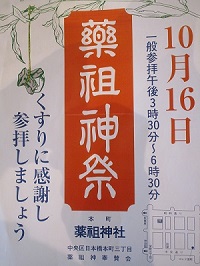 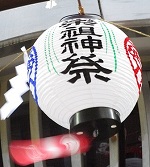
The Yaku ancestor patron Festival originated in 1908 (Meiji 41) when the Tokyo Pharmaceutical Trade and Commerce Association (now the Tokyo Pharmaceutical Association) welcomed the spirit of the god of medicine from Gojo Ten Shrine (Taito Ward) and started in 1929 (Showa 4), and the scale of the festival wasancestor patron. In 1954, a shrine hall was built on the roof of the newly completed Showa Yakugaku Building in 1983, and the festival was inherited.
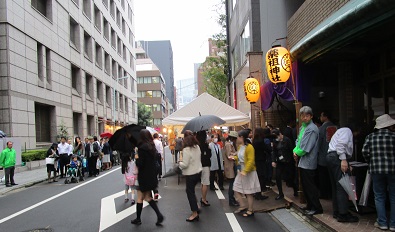 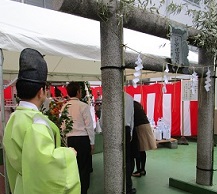 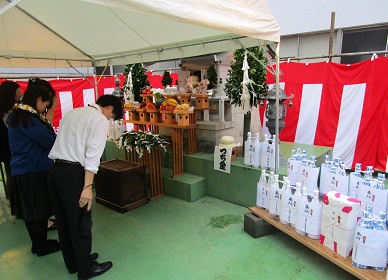
At 13:30, a ceremony was held at Yaku ancestor patron on the roof of the Showa Yaku Trade Building, attended by members of the supporting members. After that, general worship was held from 15:30 to 18:30, and a long line of worshipers was formed in front of the Showa Yaku Trade Building. It is said that "Shinko", a lucky decoration, will be distributed to all members, and "votive lanterns" with the name of the member are arranged and lit. On the street of the Showa Yaku Trade Building, a special stall was set up, and the sound of the flute and drums of "Obayashi" was excited by the festival.
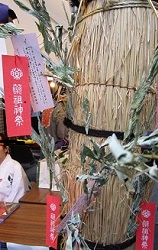 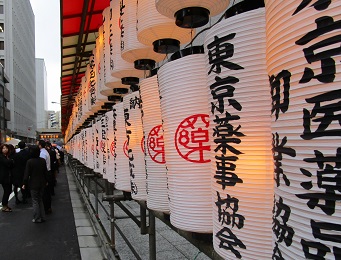 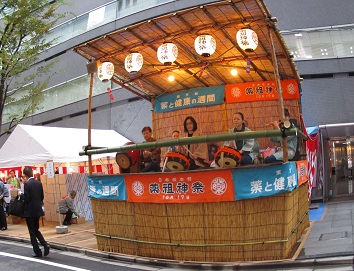
The worshipers were served with sacred wine and soup flour, as well as many pharmaceutical companies offering prizes, and those who won the lottery were given "Fukubukuro". The neighborhood of Nihonbashi Honmachi was crowded with people visiting medicine ancestor patron.
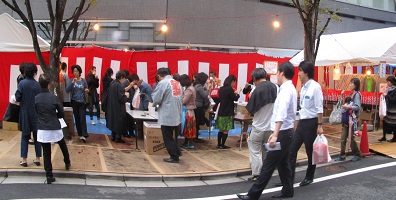 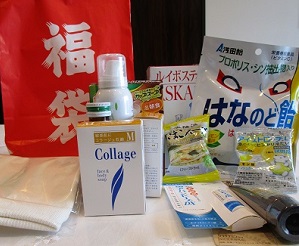
I wish you all the best in sound health and next year. I'd like to go to see you again next year.
If you haven't been this year, why don't you come next year?
[CAM]
October 21, 2015 09:00
In 1910 (1910), the first cafe in Tokyo, "Maizon Konosu" opened in Koamicho, Nihonbashi-ku, as "Ginza, which has regained its liveliness through the earthquake reconstruction project." Ginza's first cafe "Cafe Plantan" opened in March of the following year, and in August of the same year, a three-story "Cafe Lion" opened at the current Ginza 5-chome corner. ・・ ・ ・ ・ ・ ・ ・ In the Taisho era, the success of “Cafe Lion” became a prime water, and cafes opened in Ginza Brick Street one after another. Ginza will enter a gorgeous era with the scent of Taisho romance. As stated (page 122), "Ginza's first cafe" was "Cafe Plantan".
"Cafe Plantan" was opened by Shozo Matsuyama, a native of Tokyo Bijutsu School, and is 20 Hiyoshicho, Kyobashi-ku, Tokyo (currently 8-6-24 Ginza, Chuo-ku, near Ginza Kaikan). It was named by Kaoru Osanai, the consultant.
In the early Showa era, it became a customs business that exclusively used women-class entertainment as a cucumber, but until then, cafes were also serving as restaurants, bars, and coffee shops.
"Maison Konosu" was close to Western restaurants, but "Cafe Plantan" served coffee and Western liquor, and dishes served rare menus such as sausage and macaroni gratin. Later, baked sandwiches became a specialty.
Inside the "Cafe Plantan" store (copy from wikipedia, public domain confirmed)
![Cafe_Printemps_Interior[1]. jpg](https://en.tokuhain.chuo-kanko.or.jp/archive/Cafe_Printemps_Interior%5B1%5D.jpg)
|
Links
|
![IMG_1851[1]. jpg](https://en.tokuhain.chuo-kanko.or.jp/archive/IMG_1851%5B1%5D.jpg)
![Tokyo_koshin-kyoku_poster[1]. jpg](https://en.tokuhain.chuo-kanko.or.jp/archive/Tokyo_koshin-kyoku_poster%5B1%5D.jpg) (Copy from wikipedia, public domain confirmed)
(Copy from wikipedia, public domain confirmed)![1911_gaikan[1]. jpg](https://en.tokuhain.chuo-kanko.or.jp/archive/1911_gaikan%5B1%5D.jpg)
![1911_tennai[1]. jpg](https://en.tokuhain.chuo-kanko.or.jp/archive/1911_tennai%5B1%5D.jpg)










![Cafe_Printemps_Interior[1]. jpg](https://en.tokuhain.chuo-kanko.or.jp/archive/Cafe_Printemps_Interior%5B1%5D.jpg)

